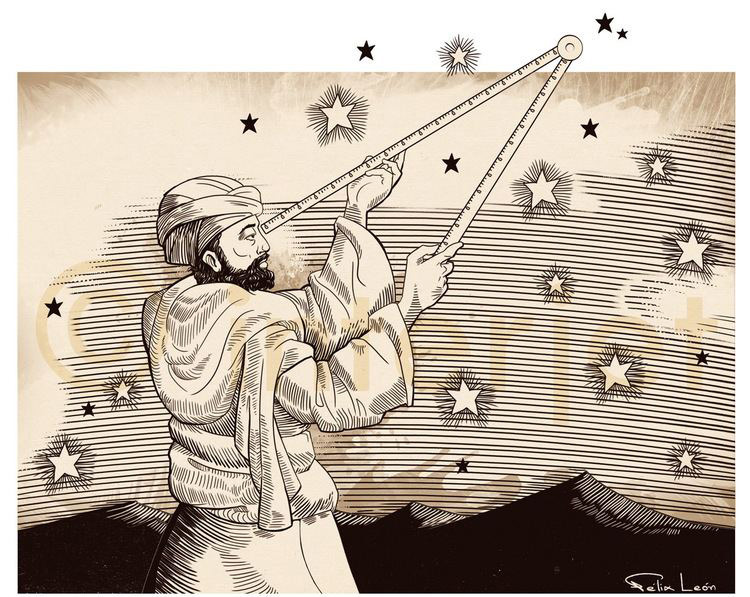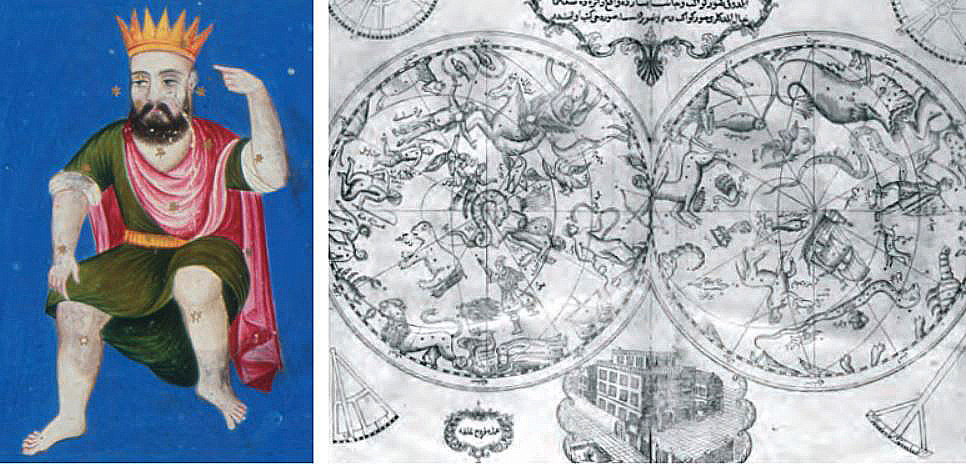Google Arts & Culture: Artistic representation of the celestial dome of Qusayr Amra in Jordan. © 1001 Inventions
 Artistic drawing of Abd al-Rahman al-Sufi, (Source) Artistic drawing of Abd al-Rahman al-Sufi, (Source) |
’Abd al-Rahman al-Sufi, a Persian astronomer, lived during the tenth century. In 964, he described the Andromeda galaxy, our closest neighbour, calling it “little cloud.” This was the first written record of a star system outside our own galaxy.
Al-Sufi set out his results constellation by constellation, discussing the stars’ positions, sizes and colours, and for each constellation he produced two drawings, one from the outside of a celestial globe and the other from the inside.[1] He also wrote about the astrolabe and its uses.
Today, more than 165 stars still have names that reflect their original Arabic names, such as Aldebaran, meaning “Follower,” of the Pleiades, and Altair, meaning “The Flying Eagle.[2] The constellation Cepheus, or qifa’us in Arabic. Bottom right: The manual of cosmography in Turkish by Mustafa ibn Abdallah.
The constellation Cepheus, or qifa’us in Arabic. Bottom right: The manual of cosmography in Turkish by Mustafa ibn Abdallah.
(Source: 1001 Inventions: The Enduring Legacy of Muslim Civilization, 3rd edition, page 294)
During Muslim civilisation, star maps and astronomical tables devised, and both of these would be used in Europe and the Far East for centuries. Maps of the heavens also appeared in art, such as on the dome of a bathhouse at Qusayr ’Amra, a Jordanian palace built in the eighth century, which has a unique hemispherical celestial map. The surviving fragments of the fresco show parts of 37 constellations and 400 stars.
 Google Doodle’s Abd al-Rahman Al-Sufi’s (Azophi) 1113th Birthday (Source)
Google Doodle’s Abd al-Rahman Al-Sufi’s (Azophi) 1113th Birthday (Source)
References
[1] C. Ronan, The Arabian Science, in The Cambridge Illustrated History of the World’s Science (Cambridge University Press, 1983), 201-44, at 213.
[2] P. Kunitzsch, The Arabs and the Stars: texts and traditions on the fixed stars, and their influence in medieval Europe (Variorum, Aldershot, 1989).
Get the full story from 1001 Inventions: The Enduring Legacy of Muslim Civilization Reference (4th Edition) Annotated.
www.amazon.co.uk/1001-Inventions-Civilization-Reference-Annotated-ebook/dp/B0775TFKVY/
 The Pleiades star group, known in Arabic as Al-Thurayya (Source: 1001 Inventions: The Enduring Legacy of Muslim Civilization, 3rd edition, page 295)
The Pleiades star group, known in Arabic as Al-Thurayya (Source: 1001 Inventions: The Enduring Legacy of Muslim Civilization, 3rd edition, page 295)

